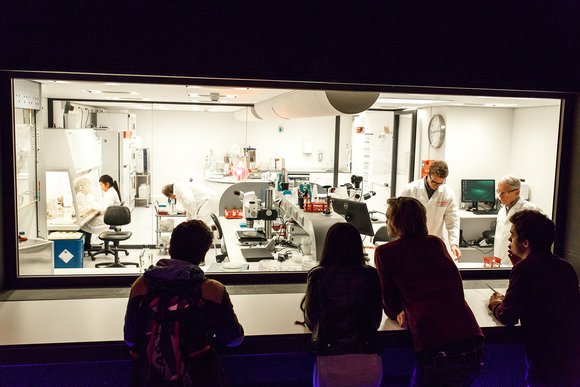Throat infections like this are caused by microbes known as pathogens, or pathogenic microbes. I now work in a laboratory where, together with various colleagues, I investigate many different types of microbes. But not all of the organisms we work on are pathogenic. That means they don’t make you ill, and we want to keep it that way!

My colleagues at work in the laboratory of Micropia.
Indeed, we would not be allowed to cultivate pathogenic microbes in Micropia, as it is far too easy for visitors to come into contact with the laboratory. Those laboratories that do work with such organisms are equipped with air locks, special suits, and lots of disinfectant.
Happily, my GP was able to tell me more about my throat infection. Throat infections can be caused either by bacteria or by viruses. Patients are only given antibiotics if they have a bacterial infection. Antibiotics have no effect on viruses, which is why you would never be given antibiotics to treat a cold. Your immune system has to combat viruses all by itself. ‘Fortunately’ my infection turned out to be the bacterial type. The doctor could see that from the symptoms in my throat. So he sent me to the pharmacy to get a course of antibiotics. “Er, doctor, will I still be able to work?” It turned out that I posed no danger to anyone but myself. I had been walking round with this infection for quite some time, continually re-infecting myself. It switched from my larynx to my throat, and back again. But, provided that I took all of the tablets as prescribed, this would stop the infection and it would be no problem for me to continue working.

Alexander Fleming (1881-1955) at work in his laboratory at St Mary’s Hospital in London.
Antibiotics were discovered accidentally by Alexander Fleming, in 1928. That's what I love about doing research, you never know what you might discover! Fleming noticed a mould growing on an agar plate he was using to grow bacteria. He saw that the bacteria were unable to grow in the vicinity of the mould. That was due to a substance secreted by the brush mould in question (Penicillium chrysogenum). Fleming named this substance penicillin. In World War II, a huge number of people survived infections, thanks to penicillin. Even in those early days, people began searching for other antibiotics that could be used if penicillin ever became ineffective.
The Penicillium mold grows from a single spore into a visible colony, and forms antibiotic drops. Time lapse: Wim van Egmond.
When you get a course of antibiotics, you should always finish it. Even if you already start feeling better after a few days. It is always possible that a few bacteria will be left alive. These can then infect you again, and the antibiotic won’t work anymore. Such bacteria are said to be insensitive (resistant). One well-known example is MRSA (Methicillin-Resistant Staphylococcus Aureus), also known as the ‘hospital superbug’. This bacterium causes skin infections, which are difficult to treat as MRSA has become resistant to many different types of antibiotics.
And then (talk of the Devil), just a week after my visit to the GP, the European ministers of health and agriculture met to discuss antibiotic resistance. This is currently a major issue in the livestock industry. In the context of this meeting, the ministers also visited Micropia! Time for me to explore this issue in depth, as this was a unique opportunity to talk to some very smart and important people.
The animals on many livestock farms were given antibiotics as a precaution against potential infections. The problem with this approach is that it causes bacteria to become insensitive to those types of antibiotic. This can cause resistance to develop. These resistant bacteria can then enter the human body when people eat undercooked meat from such animals, for example. If they go on to develop an infection, that type of antibiotic can not be used to treat it. However, the use of antibiotics in livestock farms has now decreased by 70%, and antibiotics can only be prescribed subject to very strict conditions.
The ministers were tremendously enthusiastic about Micropia and our laboratory. It turned out to be a very interesting evening indeed. They were very impressed by the way we exhibit microbes here, and even learned a few new things during their visit!
There is much more that could be said about antibiotics, but come to Micropia and find out for yourself. My colleagues and I would really enjoy telling you the rest of the story and showing you the exhibits! For instance, I bet you don’t know what antibiotics and the earthy scent of forests have in common.
See you soon!
Ilja
